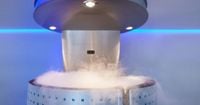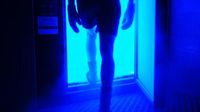A woman has died and another is in critical condition after a cryotherapy session turned deadly due to a cold chamber malfunction at a gym in Paris. The tragic incident occurred on Monday evening, April 14, 2025, at the On Air gym located on the Boulevard Voltaire in the heart of the city. According to French investigators, the gym employee, a woman in her late 20s, died after a suspected nitrogen leak from the cryochamber. Meanwhile, a client in her 30s was hospitalized in critical condition, and three individuals who attempted to provide first aid also required medical treatment.
The gym was evacuated shortly after the incident, with approximately 150 people present at the time of the malfunction. Eyewitness accounts reported seeing a body carried out of the facility covered by a white sheet, while screens were erected outside to shield the scene from public view. The Paris prosecutor's office has confirmed that an autopsy and toxicology analysis will be conducted to determine the precise cause of death.
Cryotherapy, which involves exposure to extremely low temperatures, is often touted for its therapeutic benefits, including reduced inflammation, pain relief, and accelerated recovery for athletes. However, experts have long warned about the potential risks associated with the practice, particularly when safety protocols are not adhered to. The incident in Paris echoes a similar tragedy that occurred in 2015 when a 24-year-old woman froze to death at a cryotherapy spa in Las Vegas after being left alone in a chamber for an extended period.
According to reports, the cryotherapy chamber at the Paris gym had been repaired earlier on the day of the incident. Nitrogen, a colorless and odorless gas, is commonly used in cryotherapy to achieve ultra-low temperatures, but it poses significant risks, including oxygen displacement and potential asphyxiation.
Emergency services arrived at the scene to find both women in cardiorespiratory arrest. The 29-year-old employee was pronounced dead at the scene, while the 34-year-old client was rushed to a nearby hospital. The three individuals who provided first aid were also taken to the hospital for evaluation.
As investigations continue, health experts are emphasizing the need for stricter safety measures in cryotherapy facilities. The European Industrial Gases Association had previously issued warnings in 2018 regarding the dangers of nitrogen use in cryotherapy chambers, highlighting the risks of oxygen depletion. Despite the growing popularity of cryotherapy in wellness circles, institutions like the Mayo Clinic caution that evidence supporting its benefits remains limited.
Diego Brisset, a 26-year-old who was at the gym on the day of the incident, expressed his concerns about the safety of cryotherapy. "I was always told it was dangerous," he said, noting that he had planned to work out but found the gym closed when he arrived.
The Paris incident has reignited discussions about the safety of cryotherapy as a wellness trend. While many athletes, including celebrities like Cristiano Ronaldo, have embraced the practice, experts urge caution. They point out that while cryotherapy may offer some benefits, the lack of comprehensive scientific backing raises questions about its overall efficacy and safety.
The gym in Paris has been closed indefinitely as authorities investigate the circumstances surrounding the incident. As the community grapples with the tragic loss, the focus shifts to ensuring that similar occurrences do not happen in the future. Stricter regulations and oversight may be necessary to protect individuals seeking the purported benefits of cryotherapy.
In light of this tragedy, it is crucial for potential users of cryotherapy to thoroughly research facilities and ensure that they are operated by trained professionals. Proper supervision and adherence to safety protocols are essential to mitigate the risks associated with this increasingly popular treatment.
As the investigation unfolds, the Parisian community continues to mourn the loss of a young life while grappling with the implications of this incident on the future of cryotherapy practices.







